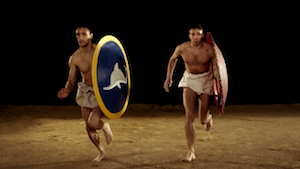
- 52'
- Author : Olivier Lemaître
- 03-08-2016
- Master : 2587
-
Share!
OLYMPIA, the origins of the games | Civilisations | France 5
Just days before the opening of the XXXIst Olympic Games in Rio (5-21 August), this documentary uses the exploration of the ruins and new technologies to reveal the site of Olympia in Greece where the sporting contests were held in ancient times. Both a religious sanctuary and a sports site, Olympia was, for nearly one thousand years, host to the most prestigious games in Ancient Greece. Every four years, athletes from all over the Mediterranean basin converged on the Peloponnesian peninsula to challenge each other in sports contests. Before cheering crowds, each athlete tried to go beyond his limits in honour of the gods. Archaeologists have uncovered a large part of the site, which had lain hidden for centuries and was discovered in 1776 by British archaeologist Richard Chandler. They found large quantities of painted pottery representing athletes. Precious evidence of the customs of antiquity. But are these scenes an accurate representation of reality? There’s something very concrete, very alluring about Greek ceramics, that triggers the temptation of a spontaneous, immediate reading of the image,” observes Anne Coulié, head curator for heritage at the Louvre Museum. “However, it would be a serious mistake to equate the person who painted the vase with a reporter, a photographer capturing the live moment of a scene at Olympia. Even though they are indeed very natural, they are often images that are constructed and codified that need to be decoded.” By using experimental archaeology. In order to have a better understanding of the practices of the period, athletes with a keen interest in history train to reproduce the ancient events, testing the athletes’ movements under real conditions. And thus they attempt foot races, discus and javelin throwing, wrestling, boxing or pancrace – a combat sport – and, also, chariot racing with two or four horses. These disciplines, which we still see for the most part in the modern games, had their specific features and their rules: going beyond oneself was more important than performances, basketball was not yet invented, nor events with a run up, but a system of leverage used weights to perform the long jump, etc. To understand the configuration of the site better, it is now possible to get a concrete visualisation of the various facilities thanks to new technologies. Using reconstructions and 3D computer imagery, this documentary by Olivier Lemaître brings the past wonders of Olympia to life and immerses the viewer in the cradle of the Olympic Games.”
